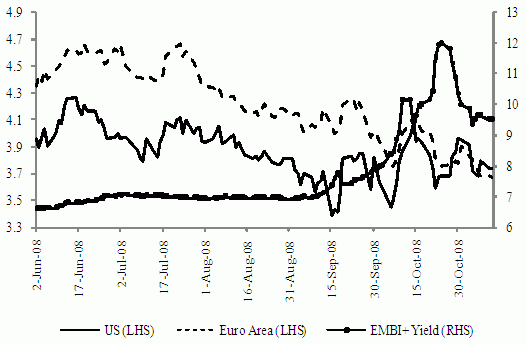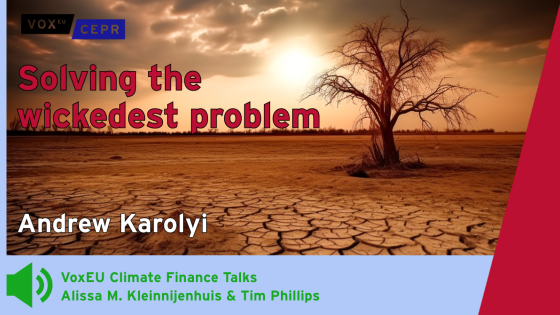One can blame the G7 for incompetent financial supervision, but few would criticise them for the rapid and decisive action taken by their central banks and fiscal authorities after the crisis materialised.
It is too early to tell if the G7 are coming out of the quagmire any time soon, but it is clear that the G7 have a powerful arsenal. The world is eager to buy their public bonds at negligible interest rates, which they can then use to pump in liquidity and bail out their financial sectors.
Emerging market woes
Unfortunately, that’s not the case in emerging market economies, or EMs in the jargon. JP Morgan’s EMBI+ bond index, for example, has become highly volatile and at one point recently it crossed the 1000 basis point mark (see Figure 1). Moreover, since the third quarter 2008, when it transpired that there was no decoupling, the EM stock market collapsed in dollar terms, and also relative to the Dow Jones.
This shows that the EM arsenal is considerably weaker than the G7’s, and that if they undertake an expansionary monetary and fiscal policy like the G7, inflation and capital flight are likely surge.1 The instruments that are helpful in refloating advanced economies could prove fatal for emerging markets!
Figure 1. Interest rates in the US, euro area and emerging markets
Notes: 10-year Generic Bond rates for the US and the Euro Area. Source: Bloomberg.
Large reserve stocks help but aren’t sufficient
The good news is that emerging markets have accumulated a sizable stock of international reserves which they could, in principle, apply to finance an expansionary fiscal policy for some time. To illustrate, consider the region composed by Africa, emerging Europe and Latin America. In 2007, gross international reserves reached around $1.7 trillion, while annual investment was about $1.8 trillion.
Suppose the current crisis shrinks investment by about 18% as it did, on average, during the Asia/Russia crises.2 This would imply a fall in investment equivalent to 1.8´0.18 = $324 billion. The stock of reserves would allow the region to offset the potential fall in investment for an impressive 5 year period. Granted, these are gross reserves, but the firepower is anyhow impressive3. The same computation for 1998, for instance, yields a much shorter period (about 2 years).
A major problem in using international reserves for credit expansion is that the stock of reserves is usually taken by market participants as a guarantee of banking and currency stability.
Data on reserves are closely followed by the private sector because, even in a reserves-rich region like Asia, international reserves do not exceed 45% of M2, on average. For instance, in the above example, if reserves fall by $324 billion, the region would have to spend about 20% of its gross reserves – a change that will not pass unnoticed to market participants. Here is where the International Financial Institutions (IFIs) can make a difference.
Loans from international financial institutions have the double effect of providing a seal of approval to the credit-expansion policy, and ensuring that the hard-currency backing of domestic monetary aggregates does not suffer a dramatic reduction. Both effects go in the direction of enhancing the trust of the private sector in domestic financial institutions. Loans from multilateral development banks, MDBs, to the region (i.e., Africa, emerging Europe and Latin America) in 2007 were slightly higher than 12% of the $324 billion required to offset the Sudden Stop (see Table 1). Even if all the MDBs follow the World Bank’s recent announcement, and expand lending by a factor of four, the additional funds would raise the MDBs’ contribution to only around 50% the above amount.
Table 1. MDBs lending to Africa, emerging Europe and Latin America (US$ billions)
| |
2004 |
2005 |
5006 |
2007 |
| Africa |
9.0 |
7.8 |
10.0 |
11.3 |
| Emerging Europe |
7.9 |
8.0 |
8.6 |
9.8 |
| Latin America |
14.8 |
17.1 |
17.8 |
20.1 |
| Total |
31.7 |
32.9 |
36.4 |
41.2 |
Note: Figures correspond to the total of approved loans and guarantees by the World Bank, the African Development Bank Group, the Inter-American Development Bank, the Andean Development Corporation and the European Bank for Reconstruction and Development.
An additional difficulty is that MDB loans take a long time to be approved and disbursed. Thus, in the short run the MDBs are unlikely to be of much help. More promising are initiatives like the Fed’s currency swaps and the IMF Short-Term Liquidity Facility. It is essential, though, that the sums involved are large enough and cover a wide spectrum of emerging markets.
The good news for emerging markets is that the G7 seem to have recognised their responsibility in generating the present financial turmoil and are coming forward with proposals to enlarge the MDBs’ lending capacity much more aggressively than in the past. To illustrate, during the Asia/Russian 1997/8 crises the MDBs increased lending by 30% (instead of the 400% recently announced by the World Bank), an amount that represented less than 5% the fall in emerging market investment (see Figure 2).
Figure 2. Investment in emerging markets and MDBs lending (US$ billions)
Note: Includes Africa, emerging Asia, emerging Europe, Latin America and the Middle East. MDB’s lending includes the total of approved loans and guarantees by the World Bank, the African Development Bank Group, the Asian Development Bank, the Inter-American Development Bank and the European Bank for Reconstruction and Development.
This, in addition to the recent and programmed G20 meetings, gives us hope that emerging markets will be offered a much more adequate cushion to a potential Sudden Stop. Optimism, however, is tempered by the fact that this time around emerging markets will likely be bereft of the net export channel, which played a very important role in their rebound from previous Sudden Stops. Unlike the 1997/98 episode, during which robust growth in the US and other advanced economies provided a strong external demand that helped the recovery in EMs, this time the global nature of the crisis will almost surely prevent this mechanism to take place.
Conclusion
Our analysis strongly suggests that, in the short run, first priority should be given to developing liquidity facilities aimed at stopping financial unravelling in EMs. At present, those facilities don’t seem to be either large enough, or cover a wide enough spectrum of EMs. Time is of the essence.
As shown by the “Sudden Stop” literature, slow response from the IFIs could result in serious output and employment losses.4 The Fund appears to be well positioned to take the lead, but its effectiveness will depend very much on getting the unambiguous political support necessary to run the large risks that the rapid expansion of sizable liquidity facilities is likely to entail.
If successful, the international financial institutions will have taken an unprecedented role in bailing out emerging markets, and for the first time, in a long time, we will be entitled to talk about a New Economic Order.
If not, and the world does not quickly recover from this crisis, there is the serious risk that many key emerging markets resort to protectionism and nationalisation, a major backward step for their economies and the world’s.
1 For a thorough evidence about the relative disadvantage of developing economies, see Carmen Reinhart, Kenneth Rogoff and Miguel Savastano “Debt Intolerance,” Brookings Papers on Economic Activity, Economic Studies Program, The Brookings Institution, vol. 34(2003-1), pages 1-74.
2 This is likely a conservative estimate. In the sample of Sudden Stops in countries from Latin America, emerging Europe and Asia, tracked in the JP Morgan’s EMBI, the average peak-to-through reduction in nominal investment was about 30% during the Asia/Russia crises.
3 In some cases, international reserves net of government short-term liabilities can be substantially lower. Take for instance, the case of Brazil. As of last October, gross reserves totaled $203 billion while public domestic short-term debt amounted to $134 billion (valued at the current exchange rate). Granted, most domestic debt is denominated in reais but the currency has already suffered a very large devaluation (almost 60% against the dollar), and there are concerns of an imminent inflation flare up. This makes it unlikely that, barring a crisis, the authorities will be inclined to let the real devalue much further – in which case, domestic debt would be de facto denominated in terms of foreign exchange.
4 See, e.g., Guillermo Calvo, Emerging Capital Markets in Turmoil, MIT Press, 2005.





